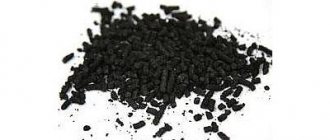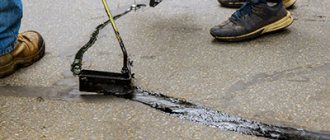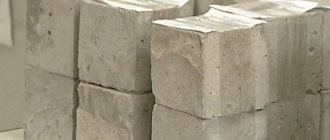The widespread use of asphalt concrete in the Russian construction industry began at the end of the nineteenth century. Due to its high-strength quality, asphalt is used for laying roads and flooring in technical premises. Amendments are made to the testing of asphalt concrete annually to improve the quality of the mixture produced.
Asphalt concrete is a material used in construction that contains mineral additives and organic material. An artificial mixture is obtained by mixing all components under high pressure and high temperature.
Types and characteristics of asphalt concrete product
The road surface includes:
- Crushed stone or gravel;
- Gravel;
- Sand;
- Mineral powder;
- Bitumen.
In the 19th and 20th centuries, coal tar was used instead of bitumen, which was later banned due to the dangerous chemical fumes released when heated.
Based on density, this mixture is divided into:
- Dense structure;
- Porous structure;
- High density structure;
- Highly porous structure.
The mixture for concreting has a coarse, fine-grained or sandy composition.
The temperature regime for surface rolling is divided into:
- Hot processing;
- Cold processing.
Production of material
The general scheme for the production of asphalt concrete is quite simple and the same for all types of asphalt concrete:
- measuring the dose of product components;
- preparation of mixture ingredients;
- mixing.
The main difference between AB and many other building materials is the need for quick application of the finished product. Otherwise, it loses viscosity, becomes brittle and is not suitable for styling. So, let's look at the basic schemes and technologies for the production of asphalt concrete.
This video will tell you more about the features of asphalt concrete production:
Technologies
The finished product is divided into 3 groups according to the manufacturing method:
- cold - solid ingredients are dried, but not heated, bitumen is heated before adding. This material is best suited for patching, filling and patching. It is allowed to work with it at a temperature not lower than - 10 C;
- hot and warm - solid ingredients are dried and heated, bitumen is heated to a higher temperature. Hot AB is more viscous and is not suitable for operation at sub-zero temperatures. However, it is precisely this that is used to build roads.
The only significant difference for the organization of production is the stage of preheating the ingredients. For the formation of a production line, the more fundamental question is the type of production: cyclical or continuous.
- The cyclic method involves the production of AB with a capacity of 100 to 300 tons per day. An undoubted advantage is the ability to quickly change the recipe: each batch can be made with a different composition. However, such a line is less mobile due to the large dimensions of the mixing tower.
- The continuous method ensures the production of asphalt concrete in a much larger volume - from 50 to 600 tons per day. Production starts literally 3 days after relocation. However, the absence of a fractionation stage here may cause a violation in the recipe. The solution to the problem is to install a separate screen for preparing solid ingredients.
Cyclic
- The main part of production is occupied by the supply system for solid ingredients - inert. Before this, the material is dosed according to the recipe of the produced AB. Mixtures with different compositions are stored in bunkers, from where they are transported to the line.
- Solid components are fed cold by a conveyor into a drying drum, where they are dried and heated by air currents.
- The material is then transferred to a vibrating screen, where crushed stone and sand are separated into different fractions based on grain diameter. This is done using a sieve system.
It is considered more economical to use a drum screen, since in this case the clogging of the pores in the sieves with dust and screenings is eliminated.
- Under the screen there are bunkers for hot solid ingredients - for each fraction. From here, a dose of material is loaded into the weigh hopper according to the recipe. The composition of the mixture is set by the program.
- Bitumen and mineral dust are loaded into their own hoppers: bitumen from the bitumen storage facility, mineral powder from the silo. Dosing is carried out using the dynamic weighing method.
- All components are transferred to the mixing chamber. The mixing cycle leaves 45 s.
- The finished battery is stored in horizontal, vertical or mobile tanks. Loaded into dump trucks.
Continuous
In many ways, the technological line here is the same, however, there are differences.
- The principle of storage in bunkers is also used here.
- The shipment of solid cold ingredients is also carried out from dispensers. But if with the cyclic method they acted as pre-dosers, since the mixture was shipped from the hot ingredient bins, then with the continuous method, it is this device that measures the dose for the mixture, and therefore is much more accurate - within 0.1%.
- Cold solid ingredients are loaded onto a conveyor equipped with an oversized screen, which is removed at this stage.
- The stone then goes to a weigh bridge, where the material is not only weighed, but data on its compliance is transmitted to the weighing system. This allows you to dynamically adjust the composition of the mixture and prevent violations in the recipe.
- The material that comes in for inspection is fed into the drying and mixing drum, where it is also dried with air.
- Here the stone is mixed with sand, mineral dust, and bitumen.
- Asphalt concrete is stored in round silos.
Equipment
The equipment used depends on the method of producing asphalt concrete and the nature of the plant - a stationary or relocating enterprise. For example, for a continuous cycle production line the following units will be needed:
- hoppers acting as a dispenser with high precision;
- collecting conveyor and conveyor with humidity control;
- mixing drum, where ingredients are dried and mixed;
- a hopper for the old battery and a supply line for the latter into the dispenser;
- vacuum cleaner-fan for removing gases and dust;
- dust collector and dust silo;
- mineral powder silo;
- bitumen tank;
- storage bunker – thermally insulated or heated.
Read on to learn how asphalt concrete production is regulated in terms of waste.
Waste
The production of asphalt concrete is of a conditionally waste-free type, since most of the dust generated during fraction separation and preparation is captured and used as part of the mineral powder. For this purpose, the line includes a dust collector and a silo for its storage.
Gases - nitrogen and carbon oxides, sulfur dioxide, and sulfur dioxide - pose a great danger to the environment. To reduce harmful effects, enterprises provide a two-stage cleaning system.
Test methods
Test methods for asphalt concrete pavement according to GOST are divided into types (depending on the density of the component) and are based on individual processing of the concrete mixture:
- Determination of density by average;
- Determination of the total mass of the composition;
- The preparation process for dynamic testing involves selecting three samples for testing;
- Next, tests are carried out by weighing and immersing samples in water;
- The last stage involves processing the obtained test results.
Asphalt production
The technology for producing asphalt concrete is quite simple. Private entrepreneurs are not afraid to invest their funds in this area. The big advantage of the material is that it can be manufactured not only in large industrial enterprises, but also in small mobile devices.
In general, the manufacturing technology is the same for all asphalt pavements:
- measuring the dosage of constituent substances;
- preparation of each ingredient;
- mixing ingredients.
Density of asphalt concrete mixture
The total density of the asphalt concrete composition is determined in two ways:
Calculation method.
Based on the average values of the total mass of the mineral part of the composition and other substances contained in asphalt concrete, the total density is calculated using the formula:
\[ p^a=\frac{q_m+q_в}{\frac{q_m}{p^о}+\frac{q_в}{p^в}} \]
The average of two samples, with a discrepancy of no more than 0.01 g per cubic meter. centimeter is included in the test result.
Pycnometric method.
In the first case, the processed samples are immersed in a vessel with water and a wetting agent, 1/3 filled. The resulting mixture is stirred and placed in a vacuum device. Maintain at a temperature of 20 degrees Celsius, add distilled water and remove after 30 minutes. Density is found using the formula:
\[ p^a=\frac{g_0p^в}{g_0+g_1+g_2} \]
Methods for assessing the quality of concrete
The asphalt analyzer is designed to determine the bitumen content in asphalt concrete.
Modern assessment of concrete quality can be carried out outside laboratory conditions (previously this was not possible). Quality control is carried out by special portable devices - density meters. The technology determines the level of coating density, level of load resistance and water saturation right on site.
The laboratory is still a popular method for quality testing. Here they can give more detailed information about all possible factors and properties. Testing asphalt concrete takes several days. Several asphalt samples are taken for analysis. The samples are then subjected to various impacts to test the quality and durability of the material.
Determination of composition
Before laying the roadway, the composition is designed in accordance with operating standards. Design helps to determine in advance the future properties of concrete and change them in accordance with the desired functions. First of all, when checking the composition, they look at the ratio of bitumen and minerals. Their ratio affects the uniformity of the material and, accordingly, the quality. Samples are tested and verified in a laboratory.
The composition is determined in asphalt analyzers (they were developed in Europe). The process lasts no more than an hour. Concrete is divided into its component parts:
- stone;
- mineral;
- bitumen.
Bitumen and solid materials are not destroyed and are subject to further research. Testing of sand and stone masses is carried out. The decomposition temperature is 80 °C.
Assessment of stability in rutting
Installation for testing for rutting.
Each country has GOST standards for regulating the resistance of concrete solutions to shear and destruction. There is a forecasting method (used for quite a long time in Europe and America). In this way, you can evaluate the track that is pushed through by the wheel.
The device used for forecasting is a sector compactor. With its help, you can prepare a concrete mixture that will be as similar as possible to the one used for road surfaces. The resulting samples are immersed in the compactor installation. It simulates mechanical damage to the material. After the experiment, special rutting graphs are modeled, which take into account:
- depth of depressions;
- approximate operating conditions;
- deadlines for the use of the roadway;
- quality and resistance to deformation of asphalt concrete.
Tests at subzero temperatures
Low temperatures change the viscosity characteristics of asphalt concrete. Essentially, the properties of the asphalt mixture change. The composition becomes more fragile, cannot withstand dynamic stress, and becomes less stable. A beam is made from the ready-made mixture, which is placed in special climatic chambers (temperature differences up to -40°C).
Tests carried out in climate chambers:
- The temperature is reduced to approximately -40°C. The samples, which are placed in the chamber, are pulled to the point of destruction.
- The temperature is gradually lowered, but no action is taken on the beam. Stress appears in the beam, it is monitored and studied. After series of temperature decreases, the beam collapses completely.
- They begin to load the beam with special materials, then suddenly remove the load. Calculate the time of tension and relaxation of the material.
- A constant temperature is set at which the material is stretched with progressive intensity. Concrete deformation is measured and possible load parameters are recorded. As a result, we obtain the values of elasticity and viscosity of asphalt.
Such testing systems are rapidly gaining popularity. Manufacturers are developing newer and better equipment to conquer the market.
Calculation of average pavement density
The average density of the asphalt concrete pavement is taken into account when calculating the value of the total density of the mass. This method examines the pores contained in samples of a substance obtained as a result of laboratory tests or directly removed from the finished coating:
- The proportion of the crushed mixture immersed in the flask is measured on a technical scale;
- The result obtained is recorded in the document;
- Parts of the samples are dipped into a vessel with water and weighed after 30 minutes;
- The final result is entered into the document, previously calculated using the formula:
\[ p^a_m=\frac{g_0p^в}{g_1-g2} \]
Water saturation of asphalt concrete
Water saturation of asphalt concrete is determined on samples previously tested for the overall density of the composition. The percentage of water content in the mixture is calculated as follows:
- Samples are immersed in a flask with water at a temperature of at least 20 C0;
- The flask is placed in a vacuum cabinet and kept under pressure (from 30 minutes to one hour, depending on the type of samples);
- Next, the parts of the mixture are weighed.
The volume fraction of water saturation is calculated using the formula: \[ W=\frac{g_3-g_0}{g_1-g_2}*100 \] - Record the obtained result in the document.
The difference in the weighing numbers of the first and second stages corresponds to the amount of water absorbed. The calculation error is 0.1%.
Technology and general rules for core sampling
Depending on the type of asphalt concrete mixture, cores are selected as follows:
- in asphalt layers from hot and warm asphalt concrete mixtures, core samples are taken no earlier than 1-3 days after their installation;
- in layers of cold asphalt concrete mixtures - no earlier than 15 days after their installation;
- in layers of asphalt-polymer concrete mixtures - no earlier than 24 hours after their installation;
- in layers of crushed stone-mastic mixtures - no earlier than 24 hours after their installation.
Core sampling is carried out at a distance of at least 1 meter from the edge of the coating or the axis of the road and at least 0.2 m from the seam. Core sampling is carried out over the entire thickness of the coating with further separation of layers in the laboratory. Sampling is carried out at the rate of: 1 sample from every 3000 m2 or 3 samples from every 7000 m2 of coverage. Core sampling from asphalt concrete pavements of intra-block driveways, sidewalks, pedestrian paths, platforms, external stairs, ramps and blind areas is carried out on the basis of at least one sample from an area of no more than 2000 m2. In areas located in close proximity to the junction lanes, samples are taken on the traffic lane (no closer than 1 meter from the junction). The sizes and number of cores that are taken from one place are determined based on the number of samples required for testing. The diameter of the cores must be no less than:
- 50 mm - for samples of sandy asphalt concrete;
- 70 mm - for samples of fine-grained asphalt concrete;
- 100 mm - for samples of coarse asphalt concrete.
From thin-layer coatings, cores are taken together with the lower layer and then the lower layer is separated using a core cutting machine. When taking cores, the thin-layer coating should not separate from the underlying layer without applying force. The quality of asphalt granuloconcrete pavement (when restoring asphalt concrete pavements and highway bases using cold regeneration methods) is determined by cores with a diameter of 10 cm, drilled from the regenerated layer 7 days after its installation. Cores are selected in a checkerboard pattern, one for every 1000 m of the regenerated layer, including under-compacted areas.
The quality of the asphalt granuloconcrete pavement (when restoring road surfaces using the hot regeneration method) is determined using one core sample for every 500 m or three core samples for every 1000 m. When constructing road bases from black crushed stone and organomineral mixtures, control of the work is carried out by sampling cores one day after layer devices. 3 samples are taken from every 7000 m2. The quality of the finished road base layer made of black crushed stone and organomineral mixtures is assessed by the physical and mechanical indicators of cores taken a month after the layer was installed at the rate of 2 samples per 1 km.
When constructing a road base from asphalt concrete granulate (asphalt chips), the quality of the laid layer is assessed by the results of testing cores, which are taken 14 days after laying the layer in an amount of at least three per 1000 m. Core sampling is carried out with special equipment - a manual or trailed core sampler. The sequence of operations when sampling core with a core sampler is as follows:
- The core sampler is brought to the intended area of the coating, the bit is secured and the engine is started.
- The core bit is lowered onto the surface of the coating and drilling begins. To cool the crown and coating, water is continuously supplied to the drilling site (under the crown).
- The drill column is gradually buried into the coating.
- The core sampler will be moved aside after drilling is completed.
- Remove the drilled core from the coating using special forceps.
After the core is extracted, it is marked, packaged and a sampling report is drawn up. The sampling report indicates:
- date of sampling;
- designation and serial number of the sample;
- type of asphalt concrete;
- type of asphalt concrete;
- brand of asphalt concrete;
- signatures of the person responsible for sampling and the person from the controlled party.
Packaging and labeling of selected samples of asphalt concrete mixtures is carried out in such a way as to ensure the preservation of the properties of the material before testing or during storage. After the core has been extracted, the adhesion between the structural layers can be determined. Adhesion is considered satisfactory if, when removing the sample from the coating, it remains solid and does not separate into parts at the contact surfaces when struck with a hammer weighing 1 kg. The core is placed on the road surface so that the vertical axis of the core is parallel to the surface of the pavement. The blow is applied with a hammer at the point of contact between the surfaces of the structural layers. The thickness of each layer of the sample and the total thickness of each sample are measured with an accuracy of 1 mm using a caliper in accordance with DSTU GOST 166:2009 or a metal ruler in accordance with DSTU GOST 427:2009.
Water saturation of asphalt concrete
The volume of water absorption of the road surface is tested on ready-made samples or created in the laboratory, used to determine the average density:
- The finished elements are immersed in water and left for about half an hour in a vacuum apparatus;
- Then take it out, rub it with a dry cloth and weigh it on the scales;
- The formula for calculation is:
\[ W=\frac{g_3-g_0}{g_1-g_2}*100 \] - The error is no more than 0.1%.
Goals from the task
Testing asphalt concrete in the laboratory allows us to determine the material’s compliance with the requirements of GOST and design documentation. The contractors thus have the opportunity to control the suppliers of the mixture, eliminating the risk of replacing the brand specified in the contract with a cheaper one. With our help, customers and supervisory authorities can verify the efficiency of spending allocated funds or catch unscrupulous contractors in deception. The ultimate goal of our activities is to improve the quality of domestic roads.
Compressive strength of unsaturated images
Laboratory tests of asphalt concrete are carried out to identify load indicators, as a result of which the asphalt concrete composition is destroyed:
- Pre-prepared samples are removed from the air bath;
- Then they put it on the press and carry out tests.
- The tensile strength of the sample is calculated using the formula:
\[ R_{compression}=\frac{P}{F}*10^{-2} \] - Cold samples are kept in air for two hours
The discrepancy between the test results of three samples should not exceed 10%.
Purpose and classification of asphalt concrete
Asphalt concrete pavement is one of the most popular materials in road construction. Structurally, it is a composition of mineral filler (crushed stone and sand), bound with bitumen, which is laid on prepared soil - crushed stone covering.
Asphalt concrete is classified based on the following indicators:
- type of mineral filler (crushed stone, gravel, sand);
- bitumen temperature;
- size of the mineral component fraction;
- residual porosity;
- appointment.
Asphalt concrete is used for the construction of bases and surfaces of highways for various purposes (highways, intercity, urban, highways), sidewalks on city streets, roads of industrial enterprises, and airfields.
Currently, new manufacturing technologies are used for the same tasks. Polymer asphalt concretes are modern composite materials using copolymers of the styrene-butadiene-styrene type as a binder component. The use of these materials in road construction can significantly protect the route from deformation, increase the performance properties of coatings such as crack resistance and durability, make it more dense, increase the low resistance of the material to frost and shear resistance, and reduce maintenance and repair costs.
Water resistance coefficient
The water resistance coefficient of asphalt concrete is needed to determine the effect of water on the strength of the mixture:
- Saturated samples are removed from the vacuum and transferred to a container with water;
- The elements of the composition are left to mature for 15 days;
- Then they are taken out and tested for strength under pressure;
- The water resistance formula is as follows:
\[ K_{VD}=\frac{R_{VD}}{R_{20}} \]
Main aspects of testing the quality of asphalt concrete compaction
Analysis of the quality of asphalt compaction is carried out using non-destructive and destructive testing methods. To maintain the integrity of the coating, ultrasonic and radioisotope equipment is used during testing. Destructive testing techniques involve drilling cores, which will subsequently be subjected to loads under pressure.
What does the material compaction coefficient mean, what should it be equal to and how is it calculated?
The compaction coefficient of asphalt concrete is the ratio of the density indicators of a freshly extracted sample to the similar parameters of the same sample, only remolded. The core is removed from the web, subjected to a variety of performance tests, then crushed and molded into a new sample.
The normative provision SP 78.13330-2012 defines the compaction coefficient indicators as follows:
- -0.96 – covering of cold asphalts.
- -0.98 – porous and super-porous asphalt concrete, dense asphalt of categories B, D, D using hot mix technology.
- -0.99 – high and standard density asphalt concrete. Category of raw materials A and B, manufacturing technology - hot mixtures.
Sample selection
Asphalt concrete samples are taken in accordance with the GOST regulations (clause 2.3):
- A small rectangular shape is cut out or drilled (the diameter of the written sample is 50 mm, with large inclusions 100 mm, with small inclusions 70 mm).
- Remnants of core samples that have been tested are not used for sampling. The exception applies to reformed dried parts of asphalt concrete.
Samples are also prepared in three ways:
- Compact using a high-pressure press with heated molds (according to the Marshall method);
- Compact using a vibrating machine, in separate forms.
To produce mixtures in laboratory conditions, comply with the standard for processing temperature
| Type of composition | Temperature |
| Warm | From 120 to 130 C |
| Cold | 100 to 120 C |
| Hot | 100 to 110 C |
General information about core
Core (in road construction) is a sample of asphalt concrete, cement concrete or other material that has a cylindrical shape and is extracted from one or several layers of a road structure by drilling. Core sampling is carried out to control the quality of asphalt paving work, as well as to determine the physical and mechanical characteristics of asphalt concrete (thickness of the asphalt layer, degree of compaction, etc.). An alternative method for sampling paved surfaces is to obtain cuttings. The cuttings, unlike cores, are not cylindrical, but parallelepiped or cubic in shape.
Test according to GOST
Testing in accordance with GOST 12801-84 “Asphalt concrete and airfield mixtures, tar road concrete, asphalt concrete and tar concrete. Test methods" was approved on February 23, 1984 by the State Committee of the USSR Council of Ministers for Construction Affairs. Published in Russia in 1987 and covers:
- Identification of the average density of asphalt concrete;
- Total density of asphalt concrete;
- Identification of the average and total porosity of the composition;
- Identification of the components of the asphalt concrete pavement;
- Identification of the adhesion of the binder to the mineral elements of the composition;
- Detection of water saturation of the composition;
- Determining the density of the concrete mixture;
- Determining the caking properties of the composition.
Why is it carried out?
The need for sampling may arise in several cases. For example, before starting road construction, in order to select the optimal mixture composition for asphalt paving of different base and coating layers.
In addition, sampling is resorted to when disagreements arise between the contractor and the customer. Laboratory examination allows us to determine deviations from construction standards, technology violations, and inconsistencies between the materials stated in the estimate and those actually used.
Equipment
Asphalt concrete testing equipment required for laboratory testing is listed below:
- Universal density meter. Designed to control the quality of road surfaces;
- PS device. It is used to test asphalt concrete pavement on rutting;
- Vacuum installation. Designed to saturate asphalt concrete pavement samples;
- Thermometer. Measures the temperature of samples;
- Mixer. Using the device, mineral mixtures are prepared;
- PSL device. Monitors mineral compositions by caking percentage;
- Crucible. Using this installation, bitumen is burned;
- Presses for testing asphalt concrete. Samples of the desired shape are removed from the road surface;
- Scales. Designed for weighing samples.
Creating samples
When testing asphalt concrete for physical properties, cylindrical samples are selected. This happens by compacting the finished mixture in special molds.
Pressing order:
- Presses can be mechanical (manual) or hydraulic (automated). The main thing is that the press can create a pressure of 40 MPa.
- A special attachment is placed on the press, thanks to which you can make 3 samples at once.
- The forms are placed in a box to prevent deformation.
- Stopping equipment is usually installed to make it easy to remove finished samples.
- If the press is too weak to make 3 samples at once, only one mold will fit into it.
This is a generalized method of pressing asphalt concrete. For each manufacturing technology (cold, hot) it is slightly different.
Documentation
To record the results of laboratory tests, a test report is used, which includes the following points:
- Name of the brand of the tested category of asphalt concrete mixture;
- Brand name and percentage content of bituminous substances in the composition;
- Number of samples used and their sizes;
- Name of the machine apparatus taken for testing samples;
- Laboratory testing conditions;
- Description of sample deformation (cracks, volume change);
- The resulting calculations using formulas for testing;
- Initials of the person conducting the testing;
- End date of testing.
How do we interact with clients?
You can leave a request on the website, and then an employee will contact you to clarify the details and scope of work required. Based on your request, the manager makes an optimal commercial offer. After which a bilateral agreement is concluded for laboratory testing of asphalt.
Experts go to the site, select cores, conduct field tests, label the samples and send them to the research center.
Upon completion of the tests, the client receives all test reports, laboratory reports, and a report on the condition of road surfaces. If necessary, we will organize courier delivery of documentation to the customer’s office.










